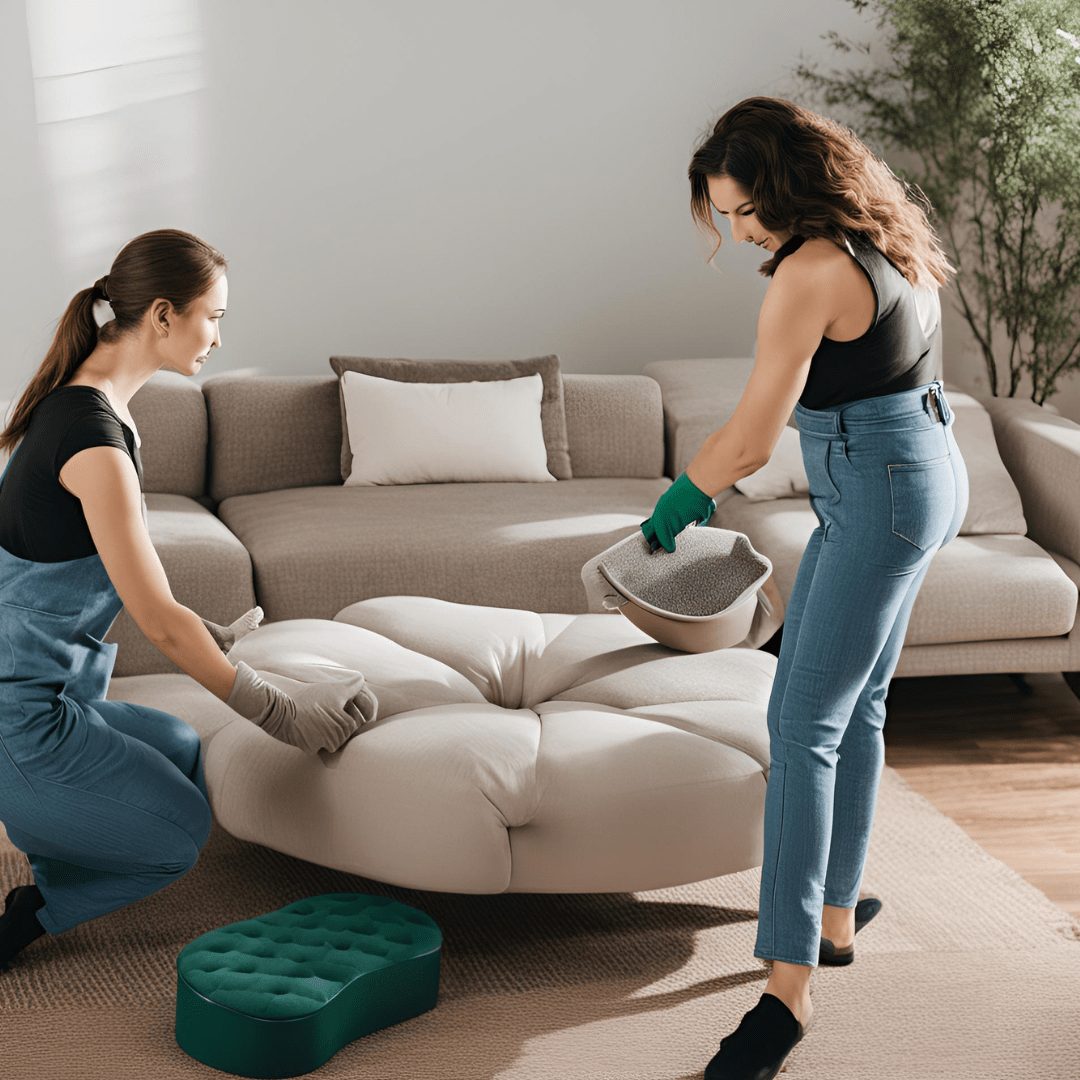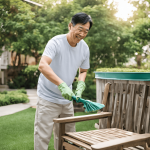
How to clean an ottoman!! vacuum it thoroughly, and spot-clean stains using a mild detergent or upholstery cleaner. Ensure it dries completely.
Cleaning your ottoman regularly not only keeps it looking fresh but also extends its lifespan. Ottomans with trays on top come in various fabrics, and each requires specific cleaning methods. Vacuuming removes dust and dirt, which can wear down the fabric over time. Spot-cleaning addresses spills and stains quickly, preventing them from setting in.
Always test a small, hidden area first before using any cleaning solution. Professional cleaning may be necessary for stubborn stains. Regular maintenance, such as fluffing and rotating cushions, also helps in preserving the ottoman’s appearance. By following these steps, you ensure your ottoman remains a comfortable and stylish addition to your living space.
Understanding Ottomans
Cleaning an ottoman can seem like a daunting task, but it becomes much easier when you understand your ottoman. Ottomans come in various shapes, sizes, and materials, each requiring different cleaning methods. Understanding your ottoman’s type and material is the first step to effective cleaning.
Different Types Of Ottomans
Ottomans come in many types, each with unique features. Knowing the type of your ottoman helps in choosing the best cleaning method.
Storage Ottomans: These ottomans have a hidden compartment. They are great for storing blankets or magazines. Cleaning these involves both the exterior and the interior storage space.
- Round Ottomans: These are perfect for small spaces and add a touch of elegance. They often have a smooth, rounded surface.
- Square Ottomans: These are versatile and can double as extra seating. Their flat surface makes them easy to clean.
- Bench Ottomans: These are long and can seat multiple people. They often have a sturdy frame and may feature tufted upholstery.
Here is a table summarizing the different types of ottomans:
| Type | Features |
|---|---|
| Storage Ottoman | Hidden compartment, multifunctional |
| Round Ottoman | Smooth, rounded surface, elegant |
| Square Ottoman | Flat surface, versatile |
| Bench Ottoman | Long, can seat multiple people |
Materials Used In Making Ottomans
Ottomans are made from various materials, each requiring different cleaning techniques. Knowing the material of your ottoman is essential for proper care.
Fabric Upholstery: This is common in many homes. It can be cleaned using a vacuum or a fabric cleaner.
- Leather: Leather ottomans are luxurious and durable. They need special leather cleaners and conditioners.
- Microfiber: Microfiber is soft and stain-resistant. It can be cleaned with a damp cloth and mild detergent.
- Velvet: Velvet ottomans are elegant but require gentle cleaning. Use a soft brush and avoid water.
Here is a table summarizing the different materials used in ottomans:
| Material | Cleaning Method |
|---|---|
| Fabric Upholstery | Vacuum, fabric cleaner |
| Leather | Leather cleaner, conditioner |
| Microfiber | A damp cloth, mild detergent |
| Velvet | Soft brush, avoid water |
Identifying The Cleaning Needs Of Your Ottoman
Cleaning an ottoman may seem simple, but identifying its cleaning needs is crucial for effective maintenance. Each ottoman is unique, requiring specific care based on its material and the level of dirt and stains. This guide will help you understand how to assess and address these needs properly.
Assessing The Material Of Your Ottoman
First, determine the material of your ottoman. Different materials require different cleaning methods. Knowing the material will help you choose the right cleaning products and techniques.
Common ottoman materials include:
- Fabric: Includes cotton, linen, and synthetic blends.
- Leather: Can be genuine or faux leather.
- Microfiber: Soft and durable synthetic fabric.
- Velvet: Luxurious fabric that needs gentle care.
Here’s a quick guide to assess the material:
| Material | Cleaning Method |
|---|---|
| Fabric | Vacuum and spot clean with mild detergent. |
| Leather | Wipe with a damp cloth and use a leather conditioner. |
| Microfiber | Use a soft brush and a mild cleaning solution. |
| Velvet | Spot clean and use a fabric brush. |
Identifying the material is the first step in ensuring your ottoman gets the necessary care.
Assessing The Level Of Dirt And Stains
Next, evaluate the dirt and stains on your ottoman. This helps you decide on the cleaning intensity required. Check for visible dirt, spills, and stains.
Follow these steps to assess the dirt and stains:
- Visual Inspection: Look for stains, spills, and dirt patches.
- Smell Test: Sniff the ottoman for any unusual odors.
- Touch Test: Feel for sticky or greasy spots.
Once you have identified the level of dirt and stains, you can choose the appropriate cleaning method:
- Light Dirt: Use a vacuum or a soft brush.
- Moderate Stains: Spot clean with mild detergent.
- Heavy Stains: Consider professional cleaning.
Regular assessments will help maintain your ottoman’s appearance and longevity.
Pre-cleaning Preparation
Cleaning your ottoman can make it look fresh and new. Before diving into the cleaning process, it’s essential to prepare properly. Pre-cleaning preparation ensures you remove all the surface dirt and debris, making the deeper cleaning more effective. This step involves a few simple tasks that can make a big difference.
Vacuuming The Ottoman
Vacuuming is the first step in pre-cleaning your ottoman. Using a vacuum cleaner with an upholstery attachment is ideal. Start by removing any cushions or covers if possible. This allows you to reach all areas of the ottoman.
Here’s a simple guide to vacuuming your ottoman:
- Choose the right attachment: Use the upholstery attachment for the best results.
- Work in sections: Divide the ottoman into smaller sections to ensure thorough cleaning.
- Use gentle strokes: Avoid pressing too hard to prevent damage to the fabric.
- Pay attention to crevices: Dirt often hides in the seams and corners. Use the crevice tool if necessary.
Here’s a quick overview in a table format:
| Step | Description |
|---|---|
| 1 | Remove any cushions or covers. |
| 2 | Attach the upholstery tool to your vacuum cleaner. |
| 3 | Work in small sections with gentle strokes. |
| 4 | Use the crevice tool for seams and corners. |
Regular vacuuming can help keep your ottoman looking new and extend its lifespan. Make it a habit to vacuum your ottoman weekly.
Removing Debris And Loose Dirt
After vacuuming, the next step is to remove any remaining debris and loose dirt. Sometimes, vacuuming might not get rid of everything. You can use a lint roller or a soft brush to tackle this.
Here are some easy steps to follow:
- Inspect the surface: Look for any visible debris that the vacuum missed.
- Use a lint roller: Roll it over the ottoman to pick up hair, lint, and other small particles.
- Brush gently: Use a soft brush to dislodge any stubborn dirt.
- Check seams and buttons: Dirt often accumulates in these areas, so pay special attention to them.
For a quick reference, consider this table:
| Tool | Purpose |
|---|---|
| Lint Roller | Remove hair, lint, and small particles. |
| Soft Brush | Dislodge stubborn dirt. |
| Crevice Tool | Clean seams and buttons. |
Cleaning your ottoman thoroughly ensures a more effective overall cleaning process. This step is crucial for maintaining the fabric’s appearance and durability.
Cleaning The Ottoman
Ottomans are stylish and functional pieces of furniture. They often serve as footrests, coffee tables, or extra seating. Keeping them clean is essential for maintaining their appearance and longevity. This guide will help you understand the steps involved in cleaning your ottoman effectively.
Using A Cleaning Solution
First, you’ll need to choose the right cleaning solution for your ottoman’s fabric. Check the manufacturer’s label on your ottoman to see if there are any specific cleaning instructions. Common fabric types include microfiber, leather, and cotton. Each type might need a different cleaning solution.
Here are some general steps to follow:
- Microfiber: Use a mixture of warm water and a few drops of mild dish soap.
- Leather: Apply a leather cleaner or a solution of equal parts water and white vinegar.
- Cotton: Use a mix of lukewarm water and mild detergent.
Prepare your cleaning solution and get a clean, soft cloth. Dampen the cloth with the solution but make sure it’s not soaking wet. Gently wipe down the surface of the ottoman, paying extra attention to any stained areas.
| Fabric Type | Cleaning Solution |
|---|---|
| Microfiber | Warm water and mild dish soap |
| Leather | Leather cleaner or equal parts water and white vinegar |
| Cotton | Lukewarm water and mild detergent |
Spot Cleaning Stubborn Stains
Stubborn stains can be challenging to remove. It’s important to act quickly to prevent the stain from setting. Start by blotting the stain with a clean, dry cloth to absorb as much of the spill as possible.
For different types of stains, use specific cleaning solutions:
- Ink stains: Dab with rubbing alcohol using a cotton ball.
- Grease stains: Sprinkle baking soda on the stain and let it sit for 15 minutes before vacuuming it up.
- Food stains: Use a mix of water and mild detergent.
Apply the cleaning solution to a cloth rather than directly on the stain. Gently blot the area, and avoid rubbing, which can spread the stain. Repeat the process until the stain is gone. Rinse the area with a clean, damp cloth to remove any residue.
Rinsing And Drying The Ottoman
After cleaning, it’s important to rinse the ottoman to remove any soap or cleaner residue. Dampen a clean cloth with plain water and gently wipe down the surface of the ottoman.
Drying the ottoman properly is crucial to prevent mold or mildew. Use a dry towel to blot excess water from the fabric. For faster drying, use a fan or place the ottoman in a well-ventilated area.
Here are some tips for effective drying:
- Avoid direct sunlight as it can fade the fabric.
- Use a hairdryer in a cool setting for spot drying.
- Check for moisture by touching the fabric after a few hours.
Once the ottoman is completely dry, you can fluff the cushions or fabric to restore its original look. Regular cleaning and proper maintenance will keep your ottoman looking great for years to come.
Maintaining The Cleanliness Of Your Ottoman
Ottomans are wonderful additions to any living space, offering both style and functionality. Keeping them clean prolongs their life and maintains their aesthetic appeal. In this guide, we will explore simple yet effective ways to maintain the cleanliness of your ottoman.
Regular Cleaning Schedule
Maintaining a regular cleaning schedule for your ottoman is crucial. It prevents dirt buildup and keeps your furniture looking fresh. Here are some steps to include in your routine:
- Weekly Dusting: Use a soft cloth or a vacuum with a brush attachment to remove dust and debris.
- Monthly Deep Cleaning: Depending on the material, you may need to use a fabric cleaner or leather conditioner.
- Spot Cleaning: Address spills and stains immediately to prevent permanent damage.
Here’s a table summarizing the cleaning schedule:
| Frequency | Task |
|---|---|
| Weekly | Dusting |
| Monthly | Deep Cleaning |
| As Needed | Spot Cleaning |
By sticking to this schedule, you ensure your ottoman remains in top condition, enhancing both its longevity and appearance.
Preventive Measures
Implementing preventive measures can significantly reduce the need for extensive cleaning. Here are some effective strategies:
- Use Slipcovers: Slipcovers protect the ottoman from spills and stains. They are easy to remove and wash.
- Avoid Direct Sunlight: Prolonged exposure to sunlight can fade the fabric or leather. Place your ottoman in a shaded area.
- Keep Pets Off: Pets can bring dirt and scratch the surface. Train them to stay off the furniture.
- Rotate Regularly: Rotating the ottoman ensures even wear and tear, maintaining its structure and appearance.
- Use Coasters and Trays: Place coasters and trays on the ottoman to prevent spills from drinks or food.
By following these preventive measures, you can keep your ottoman looking new and clean with minimal effort.
Frequently Asked Questions
How Often Should You Clean An Ottoman?
It would be best if you cleaned your ottoman every few months. Regular cleaning prevents dust build-up and stains. For high-traffic areas, clean monthly.
What Tools Do You Need To Clean An Ottoman?
Basic tools include a vacuum, mild detergent, soft cloth, and a brush. For tougher stains, consider a fabric cleaner.
Can You Machine Wash An Ottoman Cover?
Check the care label first. If machine washable, use a gentle cycle. Air dry to avoid shrinkage.
How To Remove Stains From An Ottoman?
Blot stains immediately with a soft cloth. Use mild detergent and water. For tough stains, use a fabric cleaner.
Conclusion
Maintaining a clean ottoman enhances your living space. Regular care ensures longevity and keeps it looking fresh. Use the right cleaning methods for your ottoman’s material. Spot cleaning stains promptly prevents permanent damage. With these tips, your ottoman will stay beautiful and comfortable for years.
Keep your home inviting with a clean ottoman.








